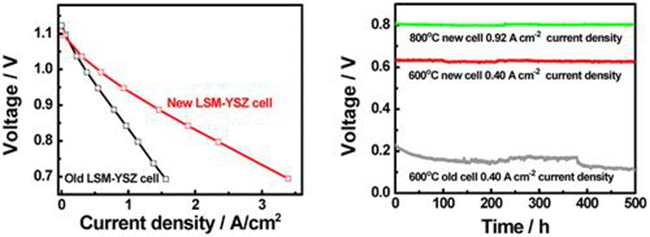Recently, the DNL0302 team led by Prof. Mojie Cheng, in collaboration with Assistant Professor Xiaobo Chen of University of Missouri, Kansas City (UMKC), made new progress in solid oxide fuel cell (SOFC). The work was just published in the recent issue of Nano Letters (Nano Lett., 2015, 15(3):1703-1709).

Solid oxide fuel cell is an energy conversion device that produces electricity by clean, efficient and environmental-friendly means. In the past decades, many efforts have been devoted to developing intermediate-temperature solid oxide fuel cells (IT-SOFCs). However, high-performance and reliable IT-SOFCs still remain a big challenge, mainly due to the sluggish oxygen-reduction-reaction (ORR) activity on cathode or poor cathode stability.
In this work, we develop a nanoparticles-loaded SOFC cathode that enhances fuel cell output (200 ? 300% power improvement), and enables superior stability from 600 to 800 °C. The high performance is likely due to the higher TPB densities from the improved LSM-YSZ particle-to-particle contact and the intimate contact between the co-loaded LSM-YSZ nanoparticles and the YSZ framework. The improved stability is likely due to the high-temperature stability of the loaded LSM nanoparticles where the co-loaded YSZ nanoparticles successfully suppress the particle growth of the LSM nanoparticles. This study provides a promising approach for obtaining stable and high-performance cathode at various operation temperatures for IT-SOFCs.
This work is financially supported by the National Natural Science Foundation of China and the Ministry of Science and Technology of China.
(By ZHAO Zhe / ZHANG Xiaomin)